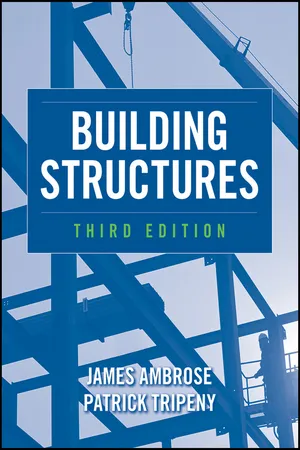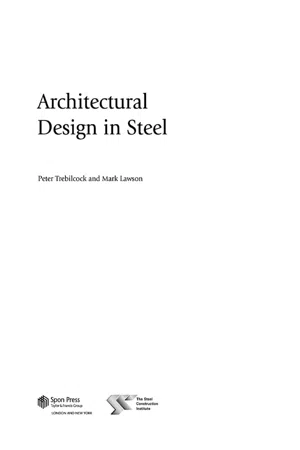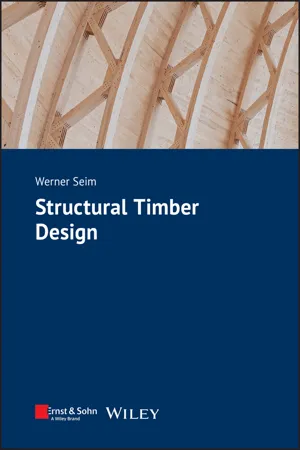Technology & Engineering
Types of Beam
Beams in engineering can be categorized into different types based on their structural behavior and shape. Common types include simply supported beams, cantilever beams, fixed beams, and continuous beams. Each type has specific applications and is designed to withstand different types of loads and forces, making them essential components in various structures and construction projects.
Written by Perlego with AI-assistance
Related key terms
1 of 5
6 Key excerpts on "Types of Beam"
- eBook - PDF
- W. C. Bolton(Author)
- 2013(Publication Date)
- Wiley-Blackwell(Publisher)
Chapter 3 Beams 3.1 Types of Beams A beam can be defined as a structural member that is designed to resist loads applied transversely at various points along it, subjecting it to bending. When beams bend they become curved with the result that one surface of the beam becomes shorter and one longer, i.e. one surface is put in com-pression and one in tension. Beams can be in the following forms. 1 A cantilever . This is a beam which, is built in or fixed at one end with the other end free to move. When a load is applied to the cantilever a reaction and a resisting moment occur at the fixed end. 2 A simply supported beam. This is a beam supported at its ends on rollers or smooth surfaces or with one of these combined with a pin at the other end. There are reactions at the supports but no resisting moments. 3 An overhanging beam. This is a simply supported beam with the supports located in some distance from the ends. There are reactions at the supports but no resisting moments. 4 A built-in beam. This is a beam with both ends rigidly fixed. There are reactions and resisting moments at both ends. The term statically determinate is used for beams, such as the cantilever, simple beam and overhanging beam, for which the reactions at the supports may be determined by the use of just the equations of static equilibrium (see chapter 1). The reactions of such beams are independent of the defor-mations of the beam. A statically indeterminate beam is one where the equations of static equilibrium have to be supplemented by equations based on the deformation of the beam. This occurs with a beam extending over three or more supports, a beam built-in at both ends, and a beam built-in at one end and propped at the other end on a roller. This chapter is concerned with statically determinate beams. The loads that can be carried by beams can be classified as concentrated or distributed. - eBook - ePub
- James Ambrose, Patrick Tripeny(Authors)
- 2011(Publication Date)
- Wiley(Publisher)
Chapter 3 Structural Elements This chapter treats the considerations for investigation of the behavior of various basic structural elements. These are the building blocks from which structural systems are developed. 3.1 BeamsThe generic name for a structural member (element) that is used for spanning, sustains lateral (perpendicular) loading, and develops internal resisting force actions of bending and shear is a beam. Depending on its particular task in a structural system, a beam may be further described as a joist , rafter, purlin , girder , header , or lintel ; however, for its fundamental behavior, it is classified as a beam.Types of BeamsThe most frequently used beam is the simple beam . As shown in Figure 3.1 a , this consists of a single-span beam with supports at each end, offering only vertical force resistance. Because the supports do not offer restraint to the rotation of the beam ends, the beam takes the simple curved form of deformation as shown in the figure.Figure 3.1 Types of Beams.Supports that do not restrain rotation are called free , pinned , or simple supports. Thus the beam in Figure 3.1 a is actually a simply supported beam, although it is more commonly called a simple beam.A cantilever beam consists of a single-span beam with only one end support, as shown in Figure 3.1 b . For stability of the beam, this support must be a rotation-resisting support, called a fixed support or a moment-resisting support .Cantilevers exist less often as shown in Figure 9.2 b than as extensions of beam ends over their supports, as shown at the right end of the beam in Figure 3.1 c . The beam with an extended end is called an overhanging beam .While the simple beam and single cantilever have deformed shapes with simple single curvature, the overhanging beam has multiple, or double, curvature (S shaped when the beam has a single extended end). This form of curvature is also found in beams that are continuous through more than one span, as shown in Figure 3.1 d - eBook - ePub
- Mark Lawson, Peter Trebilcock(Authors)
- 2004(Publication Date)
- Taylor & Francis(Publisher)
Chapter 4 Types of Beams, columns and trusses
The main types of structural members that may be encountered in general building construction are described in the following sections. These members are usually concealed or are generally not of architectural significance, but an understanding of the range of structural options is important.4.1 Beams
Beams are designed to resist bending moments and shear forces. The shapes of hot-rolled Universal Beams (UBs) listed in Table 1.1(a) are designed to achieve optimum bending properties for the use of steel. The proportions of well-designed beams fall within relatively narrow limits, depending on the form of loading. As a rule of thumb, sections with a span:depth ratio of 15 to 18 may be used in the scheme design of uniformly loaded steel beams, i.e. for a span of 10 m, the steel beam will be approximately 600 mm deep.Steel beams can also be designed to act compositely10 with a concrete floor slab by use of welded shear-connectors, a technique that has achieved great success in North America and in the UK. Its advantages have been realised in so-called ‘fast-track’ construction by using steel decking as a working platform, as permanent formwork, and as a composite slab acting with the in-situ concrete (see Section 4.1.4 on composite beams).4.1.1 Floor grillages
The layout of floor beams in buildings depends largely on the spacing of the columns. Often columns can be spaced closer together along the edges of the building, in order to support the façade elements. The primary beams span between the columns, and support secondary beams which then support the floor slab. In most buildings with regular bays, the primary beams support more load than the secondary beams, and are therefore heavier and generally deeper. However, in buildings with unequal bays (e.g. 6 m × 7.5 m), it is possible to design the primary beams to span the shorter distance between columns, so that primary and secondary beams can be designed to be of similar depth. - eBook - PDF
Mechanical Engineering Science
In SI Units
- J. L. Gwyther, W. D. Brown, G. Williams(Authors)
- 2014(Publication Date)
- Butterworth-Heinemann(Publisher)
10 Beams—shearing force and bending moment Apart from a passing reference to shearing force in Chapter 9 only the effects of direct load—either tensile or compressive—applied axially to a single member of a structure have been considered. In many cases, however, a structural member is subjected to a transverse load; this tends to bend the member rather than lengthen or shorten v it. A structural member which is subjected to transverse loads is called a beam. In this course consideration will be restricted to beams which are horizontal and those in which the transverse loads are acting vertically downwards. If a beam is to remain in equilibrium—that is, it does not move under the action of the loads—there must be forces acting vertically upwards to balance the loads which are acting vertically downwards. These upward forces act at the supports on which the beam rests, and are called support reactions. Types of Beam Simply supported beam A beam which rests on two supports without any end restraint, as in figure 10.1(a) is said to be simply supported. The supports are often, 1 t* ^ W (a) (b) (c) Figure 10.1 170 0.1 Engineering Science but not necessarily, situated at the ends. If a beam projects beyond its support it is called an overhanging beam. Figure 10.1(6). Cantilever If one end of a beam is fixed rigidly—that is, it is restrained from rotation—and the other end is free the beam is called a cantilever. Such a beam is supported at one end only—the fixed end, as shown in figure 10.1(c). Types of load Two types of load commonly occur. A load which does not extend over a measurable length of the beam is called a concentrated load. In calcula-tions it is assumed that all the load is concentrated at a single point, and the space diagram is as shown in figures 10.2(a) and (b). - eBook - PDF
- Werner Seim(Author)
- 2024(Publication Date)
- Ernst & Sohn(Publisher)
19 2 Structural Design of Beam-type Members In this chapter, the basic design requirements for linear beam-type elements are introduced and explained. The load-bearing behaviour of beam-type components is explained, and the concepts of structural safety and serviceability are introduced. The chapter explains how the scattering of the material parameters, the influence of moisture, and the duration of loading are taken into account within the scope of structural safety and serviceability. The design of beams and columns is explained with reference to the normative regulations of EC5. To facilitate the understanding, this chapter focuses solely on linear beams with constant cross sections. Tapered, curved and pitched beams are dealt with in Section 6.1. Stresses perpendicular to the grain will be treated in Chapter 3. 2.1 Basics of Structural Design Similar to any other material, timber also exhibits variations in strength and stiff- ness properties. In order to guarantee a sufficient level of safety against the failure of load-bearing elements, a certain distance between the stresses due to all conceivable effects on one hand, and resistances on the other, must be verified in the structural design (see Figure 2.1). The resistances are determined with the 5% quantile values of the material’s strengths. The 95% quantile values are used as action variables. This implies that the strengths used for the design of the components are undercut in 5% of all cases and the actions are exceeded – in relation to a defined period of time – in 5% of all cases. Both quantile values are referred to as characteristic values. To ensure a sufficient safety margin between the characteristic values of the actions E k and the load-bearing capacities R k , partial safety factors are introduced. - eBook - PDF
Building Science N3 SB
TVET FIRST
- LL Maraschin R Ferreira(Author)
- 2015(Publication Date)
- Macmillan(Publisher)
• A beam is a horizontal or inclined structural member that spans a distance between one or more supports. Beams support mainly vertical loads and have a small cross-sectional area compared with their span. • A point load (also called a concentrated loads) is a force applied at a single point on a beam. The load is given in newtons (N) or kilonewtons (kN). • A uniformly distributed load is spread over a beam in such a way that each unit of length has equal weight. The load is given in newtons per metre (N/m). • A simply supported beam is supported at two places. The supports could be at either end, or one or more of the supports can be placed further in to create an overhang. • A cantilever beam is supported at one end only with the other end overhanging and free. • Shear forces and bending moments are internal forces that are induced in a structure when a load is applied to the structure. • A shear force at any section of a beam is the algebraic sum of all the forces to the left or to the right of the section. • The international sign convention for shear forces: if the direction is upwards, it will be a positive shear force. If the direction is downwards, it is denoted by a negative sign. • A shear force diagram shows the distribution of the shear forces along the total length of the beam. − Where a point load occurs, the shear force diagram is a vertical line, either up or down, depending on the direction of the point load. − Where no load occurs, the line on the shear force diagram is horizontal. − Under a uniformly distributed load the line slopes downwards from the left to the right. • Bending moments are the bending forces induced into the material of a beam as a result of external loads, the beam’s own weight, its span, and external reactions to these loads. • The neutral axis is the area approximately in the centre of the beam’s cross-section where there are no compressive or tensile forces.
Index pages curate the most relevant extracts from our library of academic textbooks. They’ve been created using an in-house natural language model (NLM), each adding context and meaning to key research topics.





